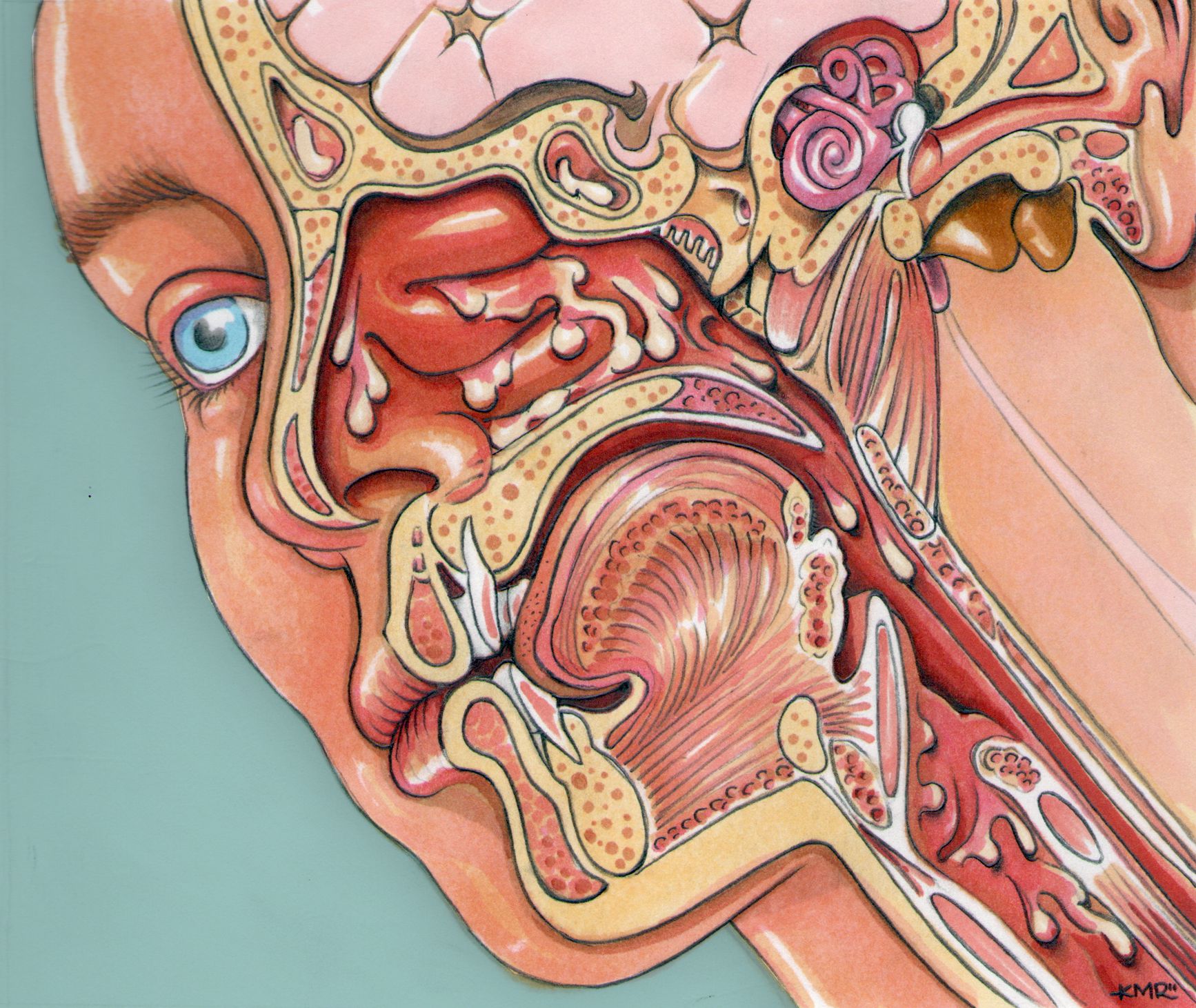
The ear, nose, and throat don’t work in isolation. Sound, airflow, and swallowing are interlinked. One signal in the ear can affect the throat’s reaction. Nasal congestion alters vocal resonance. Discomfort in one zone might originate from another. Anatomy overlaps without strict boundaries.
Cartilage shapes function, but lining determines behavior
The outer ear maintains form through elastic cartilage. Inside, soft tissue adapts. The nasal septum splits air. The throat’s flexibility comes from muscular walls, not rigid structures. Movement emerges from lining tension, not bone strength. Function arises from softness, not structure alone.
Pressure changes are regulated through more than just the ear
The eustachian tube links ear and throat. Pressure shifts with each swallow or yawn. Airways open briefly to rebalance. You don’t notice the work until dysfunction occurs. Flights, infections, and altitude changes expose the tube’s silent effort. It’s small but constant.
The nasal conchae move air even when you’re unaware
Three curved bones project into each nostril. They humidify and filter incoming air. Mucous membranes line them with vascular tissue. That tissue swells or shrinks constantly. It changes airflow patterns every few hours. One side breathes more deeply than the other, alternating in rhythm.
Hair cells determine hearing through fluid, not vibration alone
In the cochlea, movement translates to signal. Tiny hair cells detect wave patterns in endolymph. Different regions respond to different frequencies. High notes register near the base. Low ones reach the apex. These cells bend to translate sound into nerve impulses.
Behind your voice is more airflow than you expect
The vocal cords are folds, not strings. Air pushes through them during speech. Muscle tension adjusts pitch. The vibration happens in milliseconds. Without airflow, there’s no voice. Whispers involve tension without vibration. Breathing powers sound more than the cords themselves.
Smell depends on reaching one small patch high in the nose
Odors don’t activate all nasal tissue. Only the olfactory epithelium responds. It sits high, near the cribriform plate. You miss scents when airflow misses that zone. Sniffing helps guide molecules there. Without it, detection drops sharply—even with strong smells.
Drainage from the sinuses relies on narrow pathways
The paranasal sinuses surround your nose. Each has a small opening, or ostium. These channels connect to the nasal cavity. When blocked, pressure builds. Mucus thickens. Voice resonance changes. Drainage isn’t passive—it requires unobstructed passages and cilia movement.
Mucus protects by trapping more than just dust
Secretions from glands coat the nasal and throat linings. Mucus traps pathogens and particles. It also maintains moisture. Cilia move the mucus toward the throat. Swallowed unconsciously, it enters the stomach. Defense involves disposal more than destruction.
The tonsils sit between breathing and eating
Located at the oropharynx’s entrance, tonsils monitor incoming material. They sample bacteria and trigger immune responses. When swollen, they narrow the airway. Their removal changes airflow and sound but reduces infection risks. They balance protection and obstruction.
The epiglottis works without needing conscious control
Swallowing shifts the larynx upward. The epiglottis folds down to block the windpipe. It separates air from food. This action is automatic. Failure results in coughing or aspiration. It resets after each swallow, returning to a neutral, upright position.
Each region of the throat has a distinct sensory function
The nasopharynx receives air. The oropharynx manages food and sound. The laryngopharynx directs both downward. Touch and temperature sensations vary. Some regions react sharply to hot drinks. Others are dulled. Sensory maps shift gradually, not suddenly, across these borders.
Balance depends partly on ear anatomy you never feel
The vestibular system inside the inner ear detects position and movement. Semicircular canals register rotation. The utricle and saccule track gravity and linear acceleration. Fluid moves hair cells in patterns. You don’t notice until balance fails or vertigo starts.
Swelling in one passage alters sound production in the throat
Nasal obstruction affects vocal quality. It raises resonance in the pharynx. Muffled sounds emerge. Singers feel it before they hear it. Even slight inflammation shifts tone. Anatomy rebalances sound across cavities. The voice follows where the air flows.
Nerve branches overlap more than most realize
Cranial nerves V, VII, IX, and X all influence ENT functions. Touch, taste, and movement share wiring. The glossopharyngeal and vagus nerves cross paths. A sore throat might trigger ear pain. Neural maps ignore artificial borders.
Hearing loss begins in parts with no pain receptors
Hair cells in the cochlea can die silently. No ache warns you. Damage builds over years. Loud sound overstimulates cells. They stop responding, then degrade. The auditory nerve delivers less. Loss accumulates without sensation.
The nose filters and shapes airflow, but doesn’t direct it alone
The turbinates shape internal currents. Air spirals before it hits the lungs. Straight passages don’t exist. Structure matters less than surface area. Clean, moist air reaches the lungs only through detours.
Voice pitch starts deep in muscle, not at the mouth
The thyroarytenoid and cricothyroid muscles control cord length and tension. Pitch shifts before air escapes. Speech begins below the throat. Articulation fine-tunes the sound but doesn’t create tone. That happens down at the folds.
Chronic mouth breathing reshapes more than posture
Over time, oral breathing narrows airways. Tongue position drops. Palatal arch rises. Children develop different facial patterns. The nose becomes passive. Restoring nasal breathing reverses some of these changes. But timing matters. Early habits shape later form.
Taste blends smell and tongue response together
The back of the throat detects flavor through retronasal olfaction. Chewed food releases scent. It rises through the nasopharynx. Without smell, taste becomes flat. Only sweet, sour, salty, bitter, and umami remain. The rest is nasal.
Tiny bones carry massive sound information
The ossicles—malleus, incus, stapes—amplify vibrations. The stapes taps the oval window. Fluid inside the cochlea ripples. Movement begins here. Loss of vibration equals silence. The bones don’t grow, but their alignment matters deeply.
Scent molecules dissolve in mucus before triggering response
Odorants must dissolve before reaching receptors. Dry air reduces smell. Humidity enhances it. Mucus composition affects perception. A dehydrated nose underperforms. Scent fades, not from absence, but from dryness.
The pharynx carries both food and air, depending on timing
Breathing pauses during swallowing. Muscles coordinate closure. Mistiming leads to aspiration. The body juggles both tasks rapidly. These switches happen dozens of times per minute, unnoticed unless they fail.
Speech articulation depends on the soft palate’s mobility
The velum rises to close off the nasal cavity. Nasal sounds require it to lower. Its position changes with each phoneme. Even slight weakness alters clarity. Slurred speech often begins here, quietly.
Infections spread through interconnected sinus spaces
Frontal, maxillary, ethmoid, and sphenoid sinuses link through narrow paths. One infection often spreads. Blockage leads to pressure. Cross-contamination is common. Pain doesn’t reveal the full map. Imaging does.
Pressure equalization depends on swallowing, not breathing
Each swallow opens the eustachian tube briefly. This balances pressure between middle ear and throat. Inflammation blocks this motion. Pressure builds. Pain follows. Yawning also helps but less consistently.
Your voice reflects tension long before your mind notices
Stress tightens laryngeal muscles. The pitch rises. Speech shortens. Breath control slips. Even relaxed words sound sharp. The body registers load faster than the mind admits. Voice betrays the internal state.
